
Tulipa turkestanica, the Turkestan tulip, is a species of tulip native to central Asia. It was first described by Eduard August von Regel in 1873 as a variety of T. sylvestris, then elevated to full species status two years later.
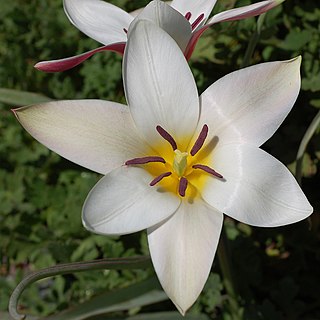
Tulipa clusiana, the lady tulip, is an Asian species of tulip native to Afghanistan, Iran, Iraq, Pakistan and the western Himalayas. It is widely cultivated as an ornamental and is reportedly naturalized in France, Spain, Portugal, Italy, Tunisia, Greece, and Turkey.

Tulips (Tulipa) form a genus of spring-blooming perennial herbaceous bulbiferous geophytes. The flowers are usually large, showy and brightly colored, generally red, pink, yellow, or white. They often have a different colored blotch at the base of the tepals, internally. Because of a degree of variability within the populations, and a long history of cultivation, classification has been complex and controversial. The tulip is a member of the lily family, Liliaceae, along with 14 other genera, where it is most closely related to Amana, Erythronium and Gagea in the tribe Lilieae. There are about 75 species, and these are divided among four subgenera. The name "tulip" is thought to be derived from a Persian word for turban, which it may have been thought to resemble. Tulips originally were found in a band stretching from Southern Europe to Central Asia, but since the seventeenth century have become widely naturalised and cultivated. In their natural state they are adapted to steppes and mountainous areas with temperate climates. Flowering in the spring, they become dormant in the summer once the flowers and leaves die back, emerging above ground as a shoot from the underground bulb in early spring.

Eriocapitella hupehensis, a species of flowering plant in the buttercup family Ranunculaceae, is native to Asia. The specific epithet hupehensis, which means "from Hupeh province, China", refers to a region where the species is known to occur. In Chinese, it is called da po wan hua hua, which means "broken bowl flower".

Tulipa urumiensis, the late tulip or tarda tulip, is a species of flowering plant in the family Liliaceae. It is a perennial growing from a bulb. By some sources the accepted name is Tulipa tarda. It has a leathery tunic that is glabrous on the inside. It has up to seven linear green leaves that can be up to 20 cm long. The stem is between 4 and 20 cm long. The yellow flowers have white tips, anthers and stamen are yellow.

Tulipa armena is a species of flowering plant in the Liliaceae family. It is referred to by the common name Armenian tulip, and is native to the historical Armenian Highlands as the name implies; current regions of Armenia, modern day Turkey, Iran, and South Caucasus.
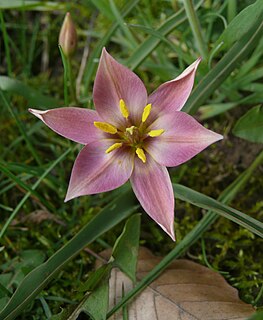
Tulipa humilis is a species of flowering plant in the lily family, found in Syria, Lebanon, Israel, Turkey, Iran, and the North Caucasus region of Russia. The flowers are pink with yellow centers. Its preferred habitat are rocky mountain slopes. It is known by several other names in horticulture.
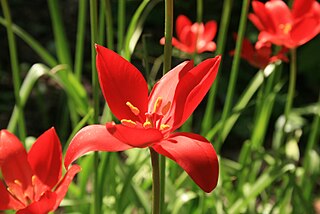
Tulipa sprengeri, or Sprenger's tulip, is a wild tulip from the Pontic coast of Turkey. It is quite rare and possibly extinct in the wild, but widely cultivated as an ornamental.
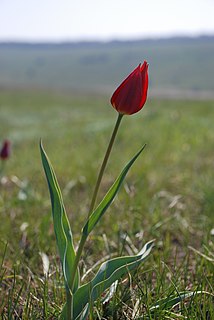
Tulipa suaveolens syn. Tulipa schrenkii, van Thol tulip, Schrenck's tulip, is a bulbous herbaceous perennial of species of tulip (Tulipa) in the family of the Liliaceae. It belongs to the section tulipa. It is the probable wild ancestor of the garden tulip.
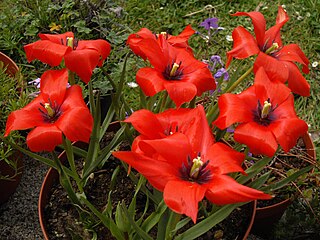
Tulipa linifolia, the flax-leaved tulip or Bokhara tulip, is a species of flowering plant in the tulip genus Tulipa, family Liliaceae, native to Tajikistan, Uzbekistan, northern Iran and Afghanistan. Growing to 20 cm (8 in) tall, it is a bulbous perennial with wavy red-margined sword-shaped leaves, and bowl-shaped red flowers in early to mid-spring. Each petal has blackish marks at the base.
Tulipa aleppensis is a wild tulip in the family Liliaceae. It is native to Southeastern Turkey, Syria, near Beirut in Lebanon.

Tulipa sylvestris, the wild tulip or woodland tulip, is a Eurasian and North African species of wild tulip, a plant in the lily family. Its native range extends from Portugal and Morocco to western China, covering most of the Mediterranean and Black Sea Basins, and Central Asia. The species is also cultivated as an ornamental and naturalized in central and northern Europe as well as a few scattered locations in North America. It is a bulb-forming perennial, usually with yellow flowers, sometimes tinged red on the outside.

Tulipa altaica is a species of tulip found in China and Kazakhstan.

The taxonomy of Tulipa places the genus in the family Liliaceae, and subdivides it as four subgenera, and comprises about 75 species.

Tulipa orphanidea is a species of flowering plant in the Liliaceae family. It was described by Pierre Edmond Boissier and Theodor Heinrich Hermann von Heldreich (1862).

Tulipa biflora, the two-flowered tulip, is a species of tulip native to the former Yugoslavia, Crimea, Anatolia, the Caucasus, southern Russia, Egypt, the Middle East, Central Asia, Iran, Pakistan, Afghanistan and Xinjiang in China. Cultivated, it has two, occasionally one or three, flowers borne on a single stalk.

Tulipa kaufmanniana, the water lily tulip, is a species of tulip native to Central Asia. They usually have outermost petals with a different color than interior petals, and often have purple markings on their leaves. They and their hybrids are placed in Group 12, the Kaufmanniana Group, by the Royal Horticultural Society. The cultivars 'Ancilla', 'Early Harvest', 'Showwinner' and 'Stresa' have gained the Royal Horticultural Society's Award of Garden Merit. Two other Group 12 cultivars are listed by the RHS as gaining the Award of Garden Merit, 'Alfred Cortot' and 'Glück'.

Tulipa greigii, Greig's tulip, is a species of tulip native to Central Asia and Iran. It is known for its variegated green and purple-maroon leaves. Its cultivars 'Oratorio', 'Plaisir', 'Red Riding Hood', 'Toronto', and 'United States' have gained the Royal Horticultural Society's Award of Garden Merit.

Tulipa praestans is a species of tulip native to Tadzhikistan. Its cultivar 'Fusilier' has gained the Royal Horticultural Society's Award of Garden Merit. It is valued by gardeners for its low growth height and habit of producing many flowers per bulb. 'Fusilier' even has a sport, 'Unicum', with the leaves edged in cream.

Tulipa kolpakowskiana, Kolpakowsky's tulip, is a species of tulip native to Afghanistan, Kazakhstan, Kirgizstan, and Xinjiang in China. Its petals display a floral iridescence which is perceived by bumblebees. It has gained the Royal Horticultural Society's Award of Garden Merit.



















